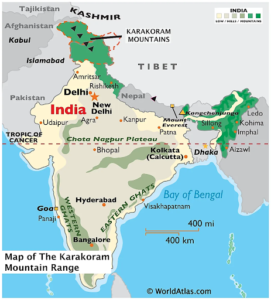In news– A team of researchers have made great progress in unravelling on why glaciers in the Karakoram Range of Central-South Asia have not been as affected by climate change as others & referred to it as Karakoram Anomaly.
What is Karakoram Anomaly?
- The ‘Karakoram Anomaly’ is termed as the stability or anomalous growth of glaciers in the central Karakoram, in contrast to the retreat of glaciers in other nearby mountainous ranges of Himalayas and other mountainous ranges of the world.
- The researchers at the Indian Institute of Science Education and Research (IISER) Bhopal have taken a significant leap and attributed this phenomenon known as the ‘Karakoram Anomaly’ .
- They have linked the recent resurgence of western disturbances (WDs) to this phenomenon.
- A report published by the Ministry of Earth Sciences in June 2020 stated that despite the declining trend in snowfall and retreat of glaciers in recent decades in several areas of Hindukush Karakoram Himalayas, the high elevation Karakoram Himalayas have experienced higher winter snowfall that has shielded the region from glacier shrinkage.
- The glaciers of central Karakoram have surprisingly remained unchanged or slightly increased in the last few decades.
- This phenomenon has been puzzling glaciologists and providing climate deniers with a very rare straw to clutch at.
Key findings of the study-
- The study has claimed that the recent revival of western disturbance has been instrumental in triggering and sustaining the Karakoram Anomaly since the advent of the 21st century.
- This is for the first time that a study brought forth the importance that enhanced WD (Western Disturbance) precipitation input during the accumulation period plays in modulating regional climatic anomalies.
- It added that WDs are the primary feeder of snowfall for the region during winters. It suggests they constitute about around 65% of the total seasonal snowfall volume and about 53% of the total seasonal precipitation, easily making them the most important source of moisture.
- The precipitation intensity of WDs impacting Karakoram has increased by around 10% in the last two decades, which only enhances their role in sustaining the regional anomaly.
- The study indicates the role of snowfall as a crucial factor in mass balance estimations.
- Earlier, the studies conducted highlighted the role of temperature in establishing and sustaining the anomaly over the years, this is for the time that the impact of precipitation in feeding the anomaly has been highlighted.
- WDs in terms of snowfall volume over the core glacier regions of Karakoram have increased by about 27% in recent decades, while precipitation received from non-WD sources has significantly decreased by around 17%.
About Karakoram range-
- The Karakoram is a large mountain range that stretches along the international boundaries of India, Pakistan, and China, with its northwestern edge extending into the countries of Afghanistan and Tajikistan.
- It forms the northwestern extension of the greater Himalayan Mountain system and covers a total area of about 207,000 sq. km.
- It contains the world’s 2nd highest peak K2 (commonly, Mount Godwin Austen) – which rises to an elevation of 8,611m.
- The range starts at Afghanistan’s Wakhan Corridor and occupies a major part of the Gilgit-Baltistan region of Pakistan, also extending into the Indian Union Territory of Ladakh, and the Aksai Chin region of China.

- It is bounded by the Aksai Chin plateau on the east; the Tibetan Plateau in the northeast and the Karakash and Yarkand River valleys in the north.
- The Indus, Gilgit, and Shyok Rivers form the entire southern boundary of the Karakoram Mountain range and separate it from the northwestern edge of the Himalayan range.
- It also forms a part of the Pamir Mountains in the northwest; the Hindu Kush mountains in the west; the Kunlun Mountains in the northeast; and the Himalayan Mountains in the southeast.
- Hindu kush Karakoram ranges form a complex and essential source to 10 major river systems in Asia, therefore supporting drinking water, irrigation, power supply and more to around 1.3 billion people.
















